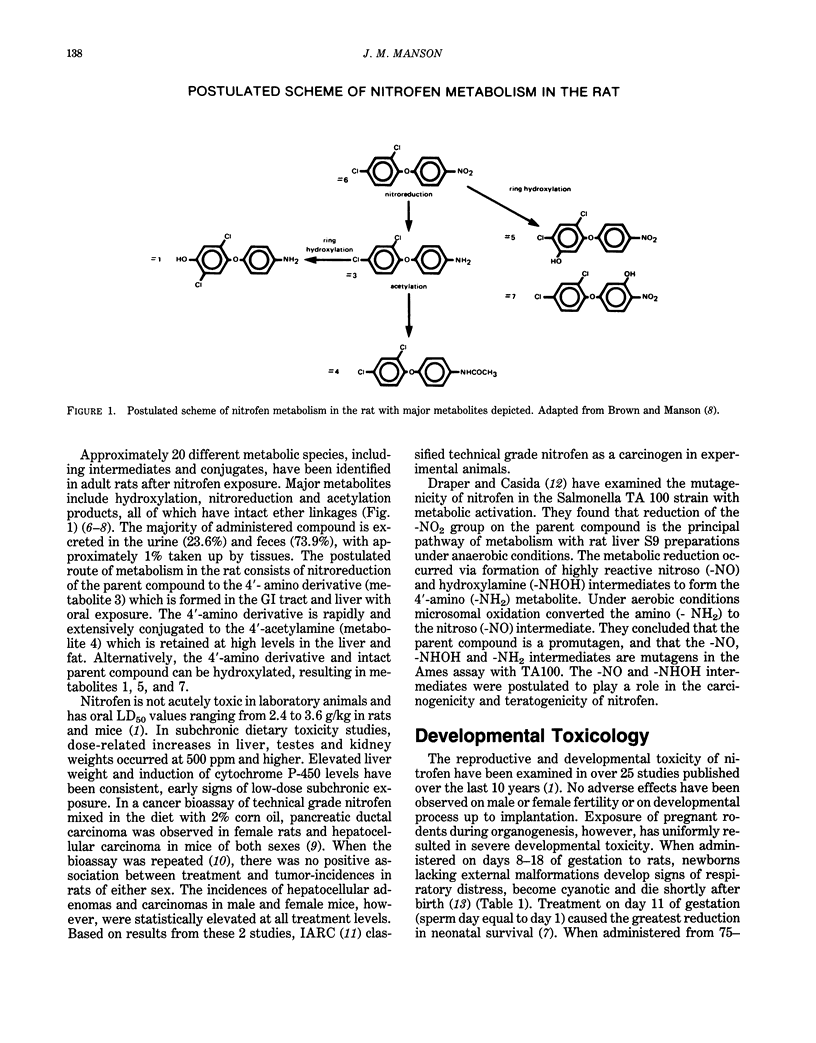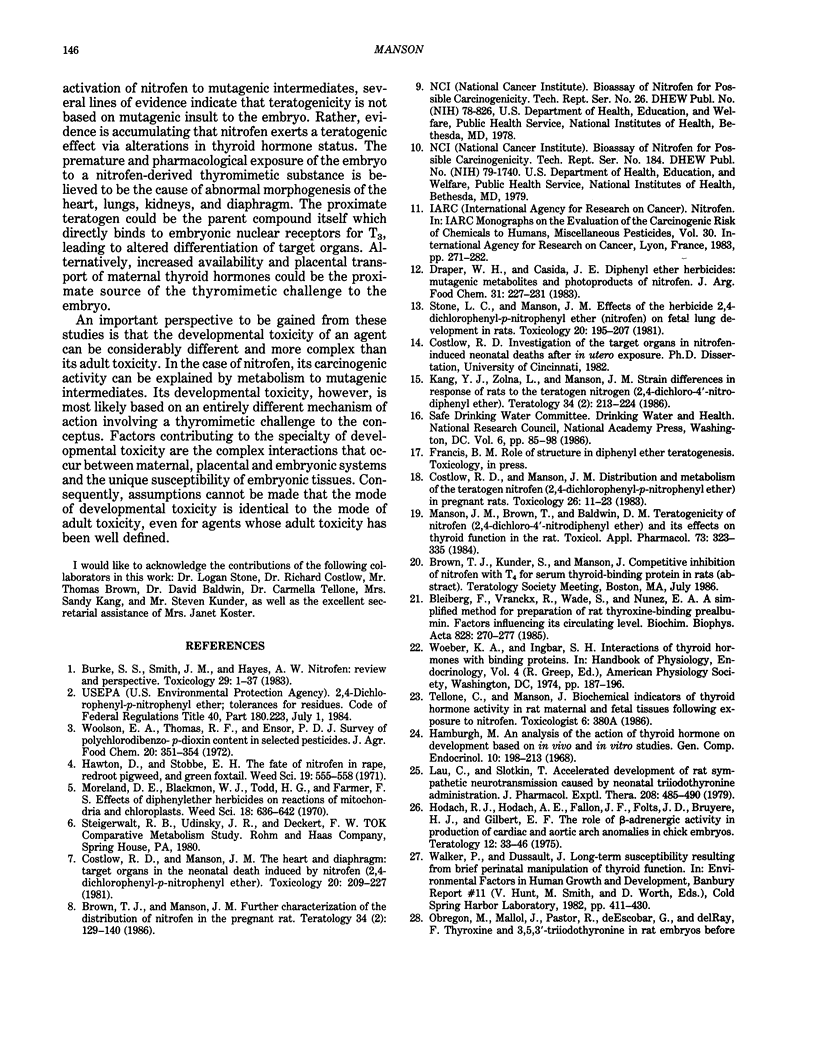Abstract
Nitrofen (2,4-dichloro-4'-nitrodiphenyl ether) is an herbicide with potent teratogenic activity in rats. When administered at doses as low as 0.15 mg/kg/day during organogenesis, abnormal development of the heart, kidneys, diaphragm, and lung occurs. The specific pattern of visceral malformations produced in the absence of overt maternal toxicity or embryolethality/cytotoxicity suggest that the compound perturbs processes unique or highly selective for embryonic differentiation. Despite findings of metabolic activation to mutagenic intermediates and carcinogenic activity in adult rodents, several lines of evidence indicate that teratogenicity is not based on mutagenic insult to the embryo. Rather, evidence is accumulating that nitrofen exerts a teratogenic effect via alterations in thyroid hormone status. The premature and pharmacologic exposure of the embryo to a nitrofen-derived thyromimetic challenge is believed to be the cause of abnormal morphogenesis of the heart, lungs, kidneys, and diaphragm. The parent compound itself could directly bind to embryonic nuclear receptors for T3, leading to altered differentiation of target organs. Alternatively, increased availability and placental transport of free thyroid hormones in the maternal compartment could be the source of thyromimetic challenge to the embryo. Overall, these studies indicate that, in the case of nitrofen, the mode of teratogenic activity is uniquely different from the mode of adult toxicity.
Full text
PDF










Selected References
These references are in PubMed. This may not be the complete list of references from this article.
- Bleiberg F., Vranckx R., Wade S., Nunez E. A. A simplified method for the preparation of rat thyroxine-binding prealbumin. Factors influencing its circulating level. Biochim Biophys Acta. 1985 Apr 29;828(3):270–277. doi: 10.1016/0167-4838(85)90308-5. [DOI] [PubMed] [Google Scholar]
- Brown T. J., Manson J. M. Further characterization of the distribution and metabolism of nitrofen in the pregnant rat. Teratology. 1986 Oct;34(2):129–139. doi: 10.1002/tera.1420340202. [DOI] [PubMed] [Google Scholar]
- Costlow R. D., Manson J. M. Distribution and metabolism of the teratogen nitrofen (2,4-dichloro-4'-nitro diphenyl ether) in pregnant rats. Toxicology. 1983 Jan;26(1):11–23. doi: 10.1016/0300-483x(83)90052-5. [DOI] [PubMed] [Google Scholar]
- Costlow R. D., Manson J. M. The heart and diaphragm: target organs in the neonatal death induced by nitrofen (2,4-dichlorophenyl-p-nitrophenyl ether). Toxicology. 1981;20(2-3):209–227. doi: 10.1016/0300-483x(81)90052-4. [DOI] [PubMed] [Google Scholar]
- Draper W. M., Casida J. E. Diphenyl ether herbicides: mutagenic metabolites and photoproducts of nitrofen. J Agric Food Chem. 1983 Mar-Apr;31(2):227–231. doi: 10.1021/jf00116a011. [DOI] [PubMed] [Google Scholar]
- Hamburgh M. An analysis of the action of thyroid hormone on development based on in vivo and in vitro studies. Gen Comp Endocrinol. 1968 Apr;10(2):198–213. doi: 10.1016/0016-6480(68)90027-0. [DOI] [PubMed] [Google Scholar]
- Hodach R. J., Hodach A. E., Fallon J. F., Folts J. D., Bruyere H. J., Gilbert E. F. The role of beta-adrenergic activity in the production of cardiac and aortic arch anomalies in chick embryos. Teratology. 1975 Aug;12(1):33–45. doi: 10.1002/tera.1420120105. [DOI] [PubMed] [Google Scholar]
- Hurt S. S., Smith J. M., Hayes A. W. Nitrofen: a review and perspective. Toxicology. 1983 Dec;29(1-2):1–37. doi: 10.1016/0300-483x(83)90036-7. [DOI] [PubMed] [Google Scholar]
- Kang Y. J., Zolna L., Manson J. M. Strain differences in response of Sprague-Dawley and Long Evans Hooded rats to the teratogen nitrofen. Teratology. 1986 Oct;34(2):213–223. doi: 10.1002/tera.1420340211. [DOI] [PubMed] [Google Scholar]
- Lau C., Slotkin T. A. Accelerated development of rat sympathetic neurotransmission caused by neonatal triiodothyronine administration. J Pharmacol Exp Ther. 1979 Mar;208(3):485–490. [PubMed] [Google Scholar]
- Manson J. M., Brown T., Baldwin D. M. Teratogenicity of nitrofen (2,4-dichloro-4'-nitrodiphenyl ether) and its effects on thyroid function in the rat. Toxicol Appl Pharmacol. 1984 Apr;73(2):323–335. doi: 10.1016/0041-008x(84)90338-7. [DOI] [PubMed] [Google Scholar]
- Morreale de Escobar G., Pastor R., Obregon M. J., Escobar del Rey F. Effects of maternal hypothyroidism on the weight and thyroid hormone content of rat embryonic tissues, before and after onset of fetal thyroid function. Endocrinology. 1985 Nov;117(5):1890–1900. doi: 10.1210/endo-117-5-1890. [DOI] [PubMed] [Google Scholar]
- Perez-Castillo A., Bernal J., Ferreiro B., Pans T. The early ontogenesis of thyroid hormone receptor in the rat fetus. Endocrinology. 1985 Dec;117(6):2457–2461. doi: 10.1210/endo-117-6-2457. [DOI] [PubMed] [Google Scholar]
- Stone L. C., Manson J. M. Effects of the herbicide 2, 4-dichlorophenyl-p-nitrophenyl ether (nitrofen) on fetal lung development in rats. Toxicology. 1981;20(2-3):195–207. doi: 10.1016/0300-483x(81)90051-2. [DOI] [PubMed] [Google Scholar]
- Woolson E. A., Thomas R. F., Ensor P. D. Survey of polychlorodibenzo-p-dioxin content in selected pesticides. J Agric Food Chem. 1972 Mar-Apr;20(2):351–354. doi: 10.1021/jf60180a068. [DOI] [PubMed] [Google Scholar]


